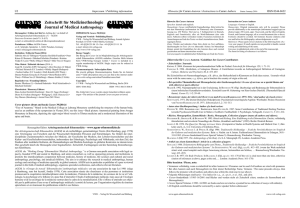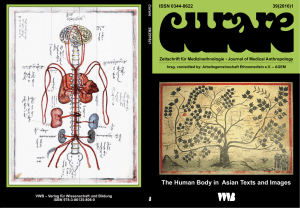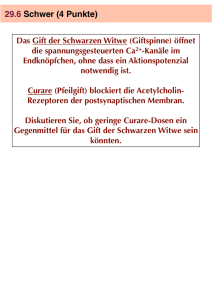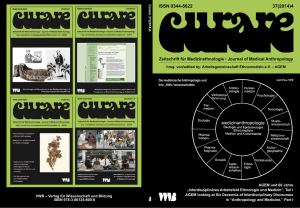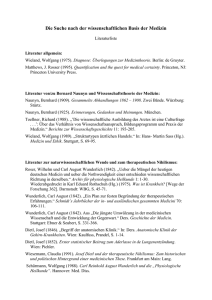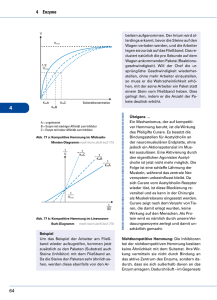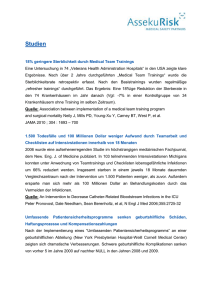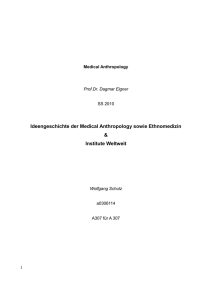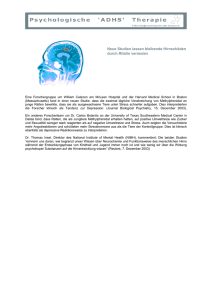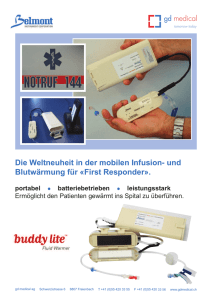China - Ratimed
Werbung
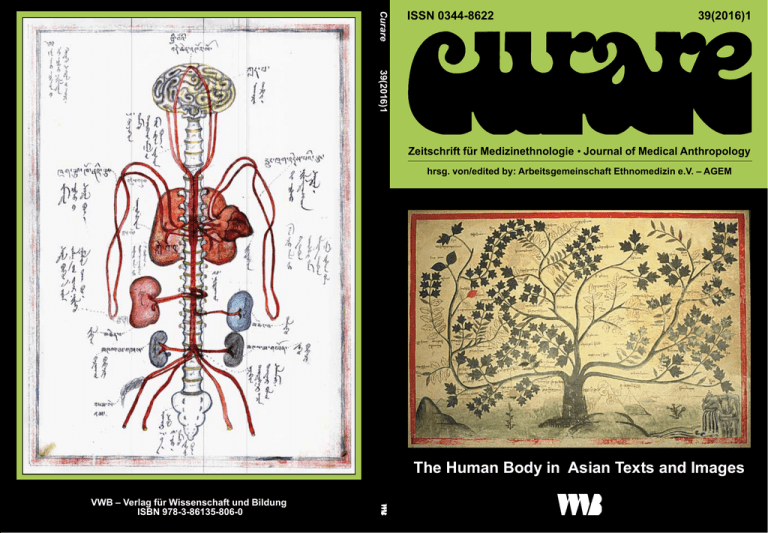
Curare ISSN 0344-8622 39(2016)1 39(2016)1 Zeitschrift für Medizinethnologie • Journal of Medical Anthropology hrsg. von/edited by: Arbeitsgemeinschaft Ethnomedizin e.V. – AGEM The Human Body in Asian Texts and Images VWB – Verlag für Wissenschaft und Bildung ISBN 978-3-86135-806-0 Impressum U2 Zeitschrift für Medizinethnologie Journal of Medical Anthropology Herausgeber / Editor-in-Chief im Auftrag der / on behalf of: Arbeitsgemeinschaft Ethnomedizin e.V. – AGEM Ekkehard Schröder (auch V. i. S. d. P.) e-mail: [email protected] (Korrespondenzadresse) Postadresse / Office: AGEM-Curare c/o E. Schröder, Spindelstr. 3, 14482 Potsdam, Germany e-mail: [email protected] Redaktion / Editorial Team (2016): Gabriele Alex (U Tübingen) • Katarina Greifeld (Frankfurt) • Peter Kaiser (U Bremen) • Ekkehard Schröder (Potsdam) • Kristina Tiedje (U Lyon) • Mirko Uhlig (U Mainz) • Ehler Voss (U Siegen) Wiss. Beirat / Editorial Advisors (2014–): Josep M. Comelles (URV Tarragona) • Alice Desclaux (U Dakar) • Michael Heinrich (UC London) • Mihály Hoppál (Budapest) • Sushrut Jadhav (UC London) • Ruth Kutalek (MU Wien) • Danuta Penkala-Gawęcka (U Poznań) • Bernd Rieken (SFU Wien) • William Sax (U Heidelberg) • Hannes Stubbe (U Köln) Begründet von / Founding Editors: Beatrix Pfleiderer (†) • Gerhard Rudnitzki • Wulf Schiefenhövel • Ekkehard Schröder Ehrenbeirat / Honorary Editors: Hans-Jochen Diesfeld (Starnberg) • Horst H. Figge (Freiburg) • Dieter H. Frießem (Stuttgart) • Wolfgang G. Jilek (Vancouver) • Guy Mazars (Strasbourg) • Armin Prinz (MU Wien) IMPRESSUM Curare 39(2016)1 Verlag und Vertrieb / Publishing House: VWB – Verlag für Wissenschaft und Bildung, Amand Aglaster Postfach 11 03 68 • 10833 Berlin, Germany Tel. +49-[0]30-251 04 15 • Fax: +49-[0]30-251 11 36 e-mail: [email protected] http://www.vwb-verlag.com Bezug / Supply: Der Bezug der Curare ist im Mitgliedsbeitrag der Arbeitsgemeinschaft Ethnomedizin (AGEM) enthalten. Einzelne Hefte können beim VWB-Verlag bezogen werden • Curare is included in a regular membership of AGEM. Single copies can be ordered at VWB-Verlag. Abonnementspreis / Subscription Rate: Die jeweils gültigen Abonnementspreise finden Sie im Internet unter • Valid subscription rates you can find at the internet under: www.vwb-verlag.com/reihen/Periodika/curare.html Copyright: © VWB – Verlag für Wissenschaft und Bildung, Berlin 2016 ISSN 0344-8622 ISBN 978-3-86135-806-0 Die Artikel dieser Zeitschrift wurden einem Gutachterverfahren unterzogen • This journal is peer reviewed. Cover pictures (front and back) Curare 39(2016)1 “Tree of Anatomy.” Mural in the Medical College at Labrang Monastery symbolizing the structure of the human body, used as an emblem of the symposium in Vienna 2014, see this issue • Back picture: Anatomical painting from Atsagat Monastery in Buryatia, depicting the eight major blood vessels in Tibetan medicine and a modernized illustration of the spine and brain. Herausgeber/Editor: Arbeitsgemeinschaft Ethnomedizin – www.agem-ethnomedizin.de Die Arbeitsgemeinschaft Ethnomedizin (AGEM) ist als rechtsfähiger, gemeinnütziger Verein (Sitz Hamburg, gegr. 1970) eine Vereinigung von Forschern und die Wissenschaft fördernden Personen und Einrichtungen. Sie fördert die interdisziplinäre Zusammenarbeit zwischen der Medizin, der Geschichte der Medizin, den Lebenswissenschaften und den Kultur- und Gesellschaftswissenschaften, insbesondere der Ethnologie, Psychologie und Volkskunde, mit dem Ziel, das Studium aller medikaler Kulturen, der Humanökologie und Medizin-Soziologie in globalen Kontexten zu intensivieren. Dies geschieht durch die Herausgabe einer begutachteten Zeitschrift, Fachtagungen und die Sammlung themenbezogenen Schrifttums. AGEM, the “Working Group ‘Ethnomedizin’/Medical Anthropology,” is a German non-profit association with legal capacity, founded 1970 and seated in Hamburg, and unites researchers as well as sponsoring persons and institutions to promote the interdisciplinary cooperation between medicine, history of medicine, life sciences and cultural and social anthropology, psychology, and (medical) folklore. The aim is to enhance the research in medical anthropology, human ecology and sociology of medicine especially in global contexts. AGEM acts in particular as publisher of a peer reviewed journal in the field of medical anthropology, organizes specialist conferences, and collects relevant literature. AGEM, le « Groupe de travail ‘Ethnomédecine’/anthropologie médicale » est une association du type Loi 1901 (siège à Hambourg, sans but lucratif, fondée 1970). Cette association réunie des chercheurs et des personnes et institutions promouvant la coopération interdisciplinaire entre la médecine, l’histoire de la médecine, les sciences de la vie et l’ethnologie, la psychologie et le folklore et a pour but d’intensifier l’étude d’anthropologie médicale, mais aussi de l’écologie humaine et de la sociologie de la médecine surtout dans le cadre de la mondialisation. Elle s’efforce d’atteindre ces objectifs par la publication d’une revue d’anthropologie médicale à comité de lecture, par l’organisation régulière de réunions spécialisées et en réunissant les publications relatifs à ces thèmes. VWB – Verlag für Wissenschaft und Bildung Hinweise für Curare-Autoren / Instructions to Curare Authors Hinweise für Curare-Autoren Sprachen: deutsch und englisch. Manuskripte: Curare veröffentlicht Originalbeiträge. Bitte liefern Sie mit dem Manuskript (unformatiert im Flattersatz) eine Zusammenfassung (ca. 250 Wörter, Titel und ca. 5 Schlagwörter) in Deutsch, Englisch und Französisch); alles als Word-Dukument (doc oder docx). Fußnoten sollten vermieden werden. Fussnoten erscheinen als Anmerkungen am Ende des Textes vor den Literaturhinweisen, Danksagungen ebenso. Zitate: Direkte und indirekte Zitate bitte direkt im Text aufführen, Quellenangabe im Text: (Autor Jahreszahl: Seiten). Im Manuskript können anstatt der Kapitälchen bei den Autoren diese auch normal geschrieben und dann unterstrichen werden. Literaturangaben in alphabetischer Reihenfolge am Ende des Textes: Stand/Status: January 2016 U3 Instruction to Curare Authors Languages: German or English. Manuscripts: Original manuscripts only will be accepted. Please provide additionally to the manuscript (unformatted ragged type) an abstract (appr. 250 words, appr. 5 keywords, and the title) in English, French, and German language; all as a word document (doc or docx). Footnotes should be avoided. All footnotes become endnotes after text and before the bibliography, acknowledgements as well. References: Please quote in-text citations in the following form: (Author year: pages). If small capitals are not possible to handle, normal writing and underlining of the name. Literature in alphabetical order at the end of the mansuscript. The form for listing of references is as follows: Zitierweise für Curare Autoren / Guidelines for Curare Contributors • Zeitschriften / Journals: Krönke F. 2004. Zoonosen bei patoralnomadischen FulBe im Tschad. Zeitschrift für Ethnologie 129, 1: 71–91. Fainzang S. 1996. Alcoholism, a Contagious Disease. A Contribution towards an Anthropological Definition of Contagion. Culture, Medicine and Psychiatry 20, 4: 473–487. Bei Zeitschriften mit Namensdoppelungen, z. B. Africa, das Herkunftsland in Klammern am Ende dazu setzen. / Journals which occur with the same name, e. g. Africa, put in brackets the country of origin at the end. • Bei speziellen Themenheften mit Herausgeber(n) oder Gastherausgeber(n) / In case of an issue on a special theme and with editor(s) or guest editor(s): Maier B. 1992. Nutzerperspektiven in der Evaluierung. In Bichmann W. (Hg). Querbezüge und Bedeutung der Ethnomedizin in einem holistischen Gesundheitsverständnis. Festschrift zum 60. Geburtstag von Hans-Jochen Diesfeld. (Themenheft/Special theme). Curare 15, 1+2: 59–68. • Rezensierter Autor, der zitiert wird (Schüttler nach Fischer-Harriehausen 1971: 311) / cited author of a book review: Schüttler G. 1971. Die letzten tibetischen Orakelpriester. Psychiatrisch-neurologische Aspekte. Wiesbaden: Steiner. Rezension von Fischer-Harriehausen H. 1971. Ethnomedizin I, 2: 311–313. • Autor einer Buchbesprechung / Author of a book review: Pfeiffer W. 1988. Rezension von / Bookreview from Peltzer K. 1987. Some Contributions of Traditional Healing Practices towards Psychosocial Health Care in Malawi. Eschborn: Fachbuchhandlung für Psychologie, Verlagsabt. Curare 11, 3: 211–212. • Bücher, Monographien, Sammelbände / Books, Monographs, Collection of papers (name all authors and editors): Pfleiderer B., Greifeld K. & Bichmann W. 1995. Ritual und Heilung. Eine Einführung in die Ethnomedizin. Zweite, vollständig überarbeitete und erweiterte Neuauflage des Werkes „Krankheit und Kultur“ (1985). Berlin: Dietrich Reimer. Janzen J. M. 1978. The Quest for Therapy in Lower Zaire. (Comparative Studies in Health Systems and Medical Care 1.) Berkeley and L. A., CA: University of California Press. Schiefenhövel W., Schuler J. & Pöschl R. (Hg) 1986. Traditionelle Heilkundige – Ärztliche Persönlichkeiten im Vergleich der Kulturen und medizinischen Systeme. Beitr. u. Nachtr. zur 6. Intern. Fachkonferenz Ethnomedizin in Erlangen, 30.9.– 3.10.1982. (Curare-Sonderband/Curare Special Volume 5). Braunschweig, Wiesbaden: Vieweg. Blacking J. (Ed) 1977. The Anthropology of the Body. (A. S. A. Monograph 15). London: Academic Press. • Artikel aus einem Sammelband / Article in a collection of papers: Schuler J. 1986. Teilannotierte Bibliographie zum Thema „Traditionelle Heilkundige – Ärztliche Persönlichkeiten im Vergleich der Kulturen und medizinischen Systeme“. In Schiefenhövel W. et al. (Hg), a. a. O.: 413–453. (wenn das Werk mehrfach zitiert wird, sonst komplett nach obiger Anweisung zitieren, Seitenzahlen am Schluss, … Braunschweig/Wiesbaden: Vieweg: 413–453) Loudon J. B. 1977. On Body Products. In Blacking J. (Ed), op. cit.: 161–178 (if the vol. is cited more than one time, otherwise citation of references as above, pages at the end, … London: Academic Press: 161–178) Bitte beachten / Please, note: • Vornamen vollständig, wenn es einheitlich bei allen Autoren ist / Prenames can be used if all authors are cited with prenames • Bei allen Autoren und auch Herausgebern im Zitat immer Reihenfolge Name, Vorname / The name precedes always, then follows the prename with all authors and editors also within the cited oeuvre (see above). • Folgende Abkürzungen sind kursiv / Use Italics for e. g., .cf., op.cit., et al., ibid., and idem. • Curare-Sonderbände 1/1983–16/2001 sind Bücher und werden nicht als Zeitschrift zitiert, sondern als Sammelband mit Herausgeber(n) • Curare Special Volumes 1/1983–16/2001 are books and are not cited as a journal but as collection of essays with editor(s). www.agem-ethnomedizin.de www.vwb-verlag.com Inhalt 1 Zeitschrift für Medizinethnologie Journal of Medical Anthropology hrsg. von/ed. by Arbeitsgemeinschaft Ethnomedizin (AGEM) Inhalt / Contents Vol. 39 (2016) 1 The Human Body in Asian Texts and Images edited by / herausgegeben von Guest Editor Katharina Sabernig The Authors in Curare 39(2016)1 . . . . . . . . . . . . . . . . . . . . . . . . . . . . . . . . . . 2 Klaus-Dieter Mathes: Preface . . . . . . . . . . . . . . . . . . . . . . . . . . . . . . . . . . . . 3 Katharina Sabernig: Editorial . . . . . . . . . . . . . . . . . . . . . . . . . . . . . . . . . . . . 4 Articles Natalia Bolsokhoeva: Tibetan Medical Illustrations from Atsagat Medical College and Other Anatomical Achievements of the Buryat Lama and Physician D. Endonov . . . . . . . . . . . . 6 Katharina Sabernig: Anatomical Structures and the Structure of Anatomy in Tibetan Medicine. The Fourth Chapter of the Explanatory Tantra in its Commentaries . . . . . . . . . . . . . . . . 22 Florian Ploberger: Anatomical Terms of the 27 Chapters of the Subsequent Tantra (Phyi mavi rgyud) . . . . . . . . . . . . . . . . . . . . . . . . . . . . . . . . . . . . . . . . . . . . . . . . 33 Isabella Würthner: A Preliminary Study on the Function, Anatomy and Origin of the Term bsam-sevu in Tibetan Medical Literature . . . . . . . . . . . . . . . . . . . . . . . . . . . . . . 42 Rudolf pfister: On the Meditative Use of the Body Maps Found in the Composite Text “Songs of the Bodily Husk” (Ti ke ge) . . . . . . . . . . . . . . . . . . . . . . . . . . . . . . . . . . . . 56 Wung Seok Cha & Hyuk Sang Jung [with assistance of Dong Ryul Kim, You Sang Baik & Tae Woo Kim]: Body Perceptions in East Asian Culture . . . . . . . . . . . . . . . . . . . . . . . . . 75 Curare 39(2016)1 • www.agem-ethnomedizin.de 2 Contents Bibliographical Survey Michael Balk: A Bibliographical Survey of Medical Literature in Tibetan language Based on the Post-war Holdings of the State Library in Berlin: A Strand of Pearls to Enlighten Researchers . . 88 Report Stephan Kloos: Tibetan Medicine Committee Inaugural Conference. World Federation of Chinese Medicine Societies, Xining, Qinghai (China), August 7–9, 2015 . . . . . . . . . . . . . . . . . . 95 Book Reviews Theresia Hofer (Ed) 2014. Bodies in Balance. The Art of Tibetan Medicine. New York [Vincanne Adams] . . . . . . . . . . . . . . . . . . . . . . . . . . . . . . . . . . . . . . . . . . 97 Janet Gyatso. 2015. Being Human in a Buddhist World. New York. [Theresia Hofer] . . . . . . 99 Résumés français des articles de Curare 39(2016)1 . . . . . . . . . . . . . . . . . . . . . . . . . . . . . . . . . . . 102 Titelbild/Cover pictures, front and back & Impressum/publishing information . . . . . . . . . . . . . . . . . Hinweise für Autoren/Instructions to Authors . . . . . . . . . . . . . . . . . . . . . . . . . . . . . . . . . . . U2 U3 Cover pictures (front and back) Curare 39(2016)1 “Tree of Anatomy.” Mural in the Medical College at Labrang Monastery symbolizing the structure of the human body, used as an emblem of the symposium in Vienna 2014, see this issue • Back picture: Anatomical painting from Atsagat Monastery in Buryatia, depicting the eight major blood vessels in Tibetan medicine and a modernized illustration of the spine and brain. Copy deadline: March 31, 2016 Editing: Katharina Sabernig The articles of the journal Curare are peer-reviewed. The Authors in Curare 39(2016)1: • • • • • • • • • • • • • • Vincanne Adams, Prof, PhD, social and medical anthropologist (San Francisco) [email protected] – p. 97 You Sang Baik,PhD, philologist (Seoul) [email protected] – p. 75 Michael Balk, Dr Phil, indologist, tibetologist (Berlin) [email protected] – p. 88 Natalia Bolsokhoeva, PhD, philologist (Ulan-Ude) [email protected] – p. 6 Wung Seok Cha, Prof. PhD, medical history (Seoul) [email protected] – p. 75 Theresia Hofer, PhD, social and medical anthropologist (Oxford) [email protected] – p. 99 Hyuk Sang Jung,PhD, anatomical research (Seoul) [email protected] – p. 75 Dong Ryul Kim, PhD, medical history (Seoul) [email protected] – p. 75 Tae Woo Kim, PhD, medical anthropologist (Seoul) [email protected] – p. 75 Stephan Kloos, PhD, social and medical anthropologist (Vienna) [email protected] – p. 95 Klaus-Dieter Mathes, Prof Dr Phil, indologist, tibetologist (Vienna) [email protected] – p. 3 Rudolf Pfister, PhD, sinologist, medical history (Basel) [email protected] – p. 56 Florian Ploberger, Dr med, tibetologist, physician (Vienna) [email protected] – p. 33 Katharina Sabernig*, Dr med, ethnomedicine (MA), medical history (Vienna) katharina.sabernig@meduniwien. ac.at – p. 4, 22 • Isabella Würthner, PhD candidate, tibetologist (Munich) [email protected] – p. 42 * Member of AGEM, the editor of the journal Curare VWB – Verlag für Wissenschaft und Bildung • www.vwb-verlag.com Report 95 Tibetan Medicine Committee Inaugural Conference. World Federation of Chinese Medicine Societies, Xining, Qinghai (China), August 7–9, 2015 Stephan Kloos In 2014, the World Federation of Chinese Medicine Societies (WFCMS) decided, upon the initiative of Dr. Jigme Phuntsog (Qinghai Jiumei Tibetan Medicine Co.), to establish a Tibetan Medicine Committee in order to play a leadership role in standardizing and globalizing Tibetan medicine. Sponsored by Dr. Jigme Phuntsog and organized by Dr. Rinchen Dhondup, the Committee’s inaugural meeting and first annual international conference took place from August 7–9, 2015, in Xining. The WFCMS is an international non-profit organization, which aims to promote TCM and “Chinese minority medicines” globally. Comprised of 239 member organizations from 65 countries and regions, its main activities include organizing international academic exchange, fostering cooperation between Chinese and other medicines, and, most significantly, the standardization of Chinese medicines in collaboration with international bodies like WHO and ISO, in order to facilitate their inclusion into the health care systems of other countries. Given that the WFCMS’s agenda is to promote (traditional) Chinese medicine industries worldwide, the recent development of a lucrative transnational Tibetan medicine industry in China and elsewhere made the inclusion of Tibetan medicine in the WFCMS a logical step. The Inaugural Ceremony and First Annual Academic Conference of the Special Committee of Tibetan Medicine of the WFCMS successfully achieved its objectives. It was attended by WFCMS Vice-Chairman and General Secretary Lizheng Ji, IASTAM President Geoffrey Samuel, 40 invited speakers, and over 450 participants, most of whom were Tibetans, but also included over 40 Chinese, some 15 foreigners and 10 members of other minority nationalities. Thus, on the first evening, the Tibetan Medicine Committee was formally inaugurated with the appointment of its Chairman Jigme Phuntsog, General Secretary Rinchen Dhondup, and 25 Vice-Chairpersons from Tibet, China, and the West (Vincanne Adams, Sienna Craig, and Mona Schrempf), as well as the election of 53 ExCurare 39(2016)1: 95–96 ecutive Committee Members including more than a dozen international scholars of Tibetan medicine. A major aim of the conference, and indeed of the Committee, was to be as inclusive and international as possible, which was not only evidenced by the participation and election of numerous foreign Tibetan medicine scholars, but also by the wide participation of doctors from over 50 Tibetan medical and Chinese academic institutions. This diverse and high-level turnout was directly related to the third main objective, namely to foster academic exchange. The approximately 40 presentations delivered over the course of the two day conference were mostly of high quality, particularly the Tibetan-language presentations. Question and answer sessions were generally lively and surprisingly critical. While everyone agreed that Tibetan medicine needed to be further developed and promoted, opinions diverged on both technical issues as well as the larger aims and consequences involved. An inevitable challenge in any multi-lingual international conference is ensuring meaningful exchange not just among members of the same language or professional group, but also between such groups. In this case, the larger number of Tibetan presenters, who were mainly Tibetan medical professionals, was grouped together on one panel, while the comparatively smaller group of foreign and Chinese presenters shared the second panel. This arrangement had the benefit of enabling high quality exchange especially among Tibetan professionals, who did not have to waste time explaining and translating the basics of Tibetan medicine to non-professionals. It also afforded interesting insights for the Western participants regarding Chinese research (mostly phytochemical) and Chinese perspectives on Tibetan medicine (invariably pursuing a Chinese state agenda in classifying Tibetan medicine as an integral but subordinate part of the TCM family). At the same time, Chinese participants were exposed to perspectives and developments beyond China’s disciplinary and national boundaries. Exchange between the Tibetan and VWB – Verlag für Wissenschaft und Bildung Report 96 the Chinese/foreign panel, however, was limited to informal conversations during breaks, while a few individuals with sufficient language skills were also able to follow papers in the other hall. Even so, every participant I spoke to—Tibetan, Chinese, foreign—came away academically enriched and impressed by the high standard of the presentations, the conference organization, and Tibetan medicine in general. If Tibetan medicine’s inclusion into the World Federation of Chinese Medicine Societies marked its increasing official recognition as a cultural, scholarly, and economic resource, then the inclusion of several papers—most notably by Dr. Nida Chenagtsang and Geoffrey Samuel—on Tibetan medicine’s religious aspects indicated a growing acceptance of the fullness of its textual and practical traditions by the Chinese state. Indeed, foreigners familiar with the Chinese context of Tibetan medicine were struck by the ease with which ostensibly Buddhist topics—until recently carefully excluded from Tibetan medical practice and discourse in China—were discussed. At the same time, any mention of exile Tibetan medical institutions in India, by far the largest and most important centers of Tibetan medical scholarship, training, and pharmaceutical production outside China, remained firmly off limits for reasons of “political sensitivity.” This, coupled with the impossibility of inviting Tibetan experts from India, and an absence of representatives from Mongolia (Traditional Mongolian Medicine, though also classifiable as Sowa Rigpa, is considered a different minority medicine in China), Bhutan, or Buryatia, was perhaps the greatest limitation of an otherwise fairly inclusive, comprehensive, and international conference. It served as a reminder of the political dimensions that inevitably shape the development and scholarship of medicine, be it traditional or modern, in Tibet or elsewhere. However, India—which had officially recognized Sowa Rigpa as part of its national health care system in 2010—was by no means absent. Besides several foreign presentations based on data from India, the Director of the National Research Institute for Sowa Rigpa in Leh, Dr. Padma Gyurmet, gave an overview of the status and scope of research and the development of Sowa Rigpa in India, focusing on practitioners and institutions with Indian citizenship. The Government of India also considered the event important enough to depute the Third Secretary of the Indian Embassy in Beijing, Gince Kuruvilla Mattam, to Xining. No doubt owing to India’s plans for developing its own globally relevant Sowa Rigpa industry, both he and Dr. Padma Gyurmet displayed a keen interest in the advances of the Tibetan medicine industry in China. Against the background of the impressive development of Tibetan medicine as an important part of China’s—and indeed Asia’s—booming knowledge industry, the conference in Xining was another indication of the growing recognition and importance of traditional Asian medicines in the national and global health arena. While it will take some years and several more conferences before it is possible to evaluate the actual relevance and impact of the newly founded WFCMS Tibetan Medicine Committee, its inaugural conference in Xining in August 2015 was certainly a promising beginning. Stephan Kloos, PhD 2010 UC San Francisco & Berkeley, Mag. Phil. 2002 University of Vienna, Medical Anthropologist, Principal Investigator of the ERC Starting Grant Project RATIMED 2014-19 (www.ratimed. net), Group Leader at the Institute for Social Anthropology of the Austrian Academy of Sciences, has carried out research projects on Tibetan medicine for some 15 years. He has written numerous publications at the interface between medical anthropology, science studies, and postcolonial theory and history. Stephan is IASTAM Council Member, WFCMS Executive Committee Member, and member of Nomad RSI Research Unit, AAA, EASA, SMA, and SCA. For more information, please see www.stephankloos.org. e-mail: [email protected] VWB – Verlag für Wissenschaft und Bildung Impressum U2 Zeitschrift für Medizinethnologie Journal of Medical Anthropology Herausgeber / Editor-in-Chief im Auftrag der / on behalf of: Arbeitsgemeinschaft Ethnomedizin e.V. – AGEM Ekkehard Schröder (auch V. i. S. d. P.) e-mail: [email protected] (Korrespondenzadresse) Postadresse / Office: AGEM-Curare c/o E. Schröder, Spindelstr. 3, 14482 Potsdam, Germany e-mail: [email protected] Redaktion / Editorial Team (2016): Gabriele Alex (U Tübingen) • Katarina Greifeld (Frankfurt) • Peter Kaiser (U Bremen) • Ekkehard Schröder (Potsdam) • Kristina Tiedje (U Lyon) • Mirko Uhlig (U Mainz) • Ehler Voss (U Siegen) Wiss. Beirat / Editorial Advisors (2014–): Josep M. Comelles (URV Tarragona) • Alice Desclaux (U Dakar) • Michael Heinrich (UC London) • Mihály Hoppál (Budapest) • Sushrut Jadhav (UC London) • Ruth Kutalek (MU Wien) • Danuta Penkala-Gawęcka (U Poznań) • Bernd Rieken (SFU Wien) • William Sax (U Heidelberg) • Hannes Stubbe (U Köln) Begründet von / Founding Editors: Beatrix Pfleiderer (†) • Gerhard Rudnitzki • Wulf Schiefenhövel • Ekkehard Schröder Ehrenbeirat / Honorary Editors: Hans-Jochen Diesfeld (Starnberg) • Horst H. Figge (Freiburg) • Dieter H. Frießem (Stuttgart) • Wolfgang G. Jilek (Vancouver) • Guy Mazars (Strasbourg) • Armin Prinz (MU Wien) IMPRESSUM Curare 39(2016)1 Verlag und Vertrieb / Publishing House: VWB – Verlag für Wissenschaft und Bildung, Amand Aglaster Postfach 11 03 68 • 10833 Berlin, Germany Tel. +49-[0]30-251 04 15 • Fax: +49-[0]30-251 11 36 e-mail: [email protected] http://www.vwb-verlag.com Bezug / Supply: Der Bezug der Curare ist im Mitgliedsbeitrag der Arbeitsgemeinschaft Ethnomedizin (AGEM) enthalten. Einzelne Hefte können beim VWB-Verlag bezogen werden • Curare is included in a regular membership of AGEM. Single copies can be ordered at VWB-Verlag. Abonnementspreis / Subscription Rate: Die jeweils gültigen Abonnementspreise finden Sie im Internet unter • Valid subscription rates you can find at the internet under: www.vwb-verlag.com/reihen/Periodika/curare.html Copyright: © VWB – Verlag für Wissenschaft und Bildung, Berlin 2016 ISSN 0344-8622 ISBN 978-3-86135-806-0 Die Artikel dieser Zeitschrift wurden einem Gutachterverfahren unterzogen • This journal is peer reviewed. Cover pictures (front and back) Curare 39(2016)1 “Tree of Anatomy.” Mural in the Medical College at Labrang Monastery symbolizing the structure of the human body, used as an emblem of the symposium in Vienna 2014, see this issue • Back picture: Anatomical painting from Atsagat Monastery in Buryatia, depicting the eight major blood vessels in Tibetan medicine and a modernized illustration of the spine and brain. Herausgeber/Editor: Arbeitsgemeinschaft Ethnomedizin – www.agem-ethnomedizin.de Die Arbeitsgemeinschaft Ethnomedizin (AGEM) ist als rechtsfähiger, gemeinnütziger Verein (Sitz Hamburg, gegr. 1970) eine Vereinigung von Forschern und die Wissenschaft fördernden Personen und Einrichtungen. Sie fördert die interdisziplinäre Zusammenarbeit zwischen der Medizin, der Geschichte der Medizin, den Lebenswissenschaften und den Kultur- und Gesellschaftswissenschaften, insbesondere der Ethnologie, Psychologie und Volkskunde, mit dem Ziel, das Studium aller medikaler Kulturen, der Humanökologie und Medizin-Soziologie in globalen Kontexten zu intensivieren. Dies geschieht durch die Herausgabe einer begutachteten Zeitschrift, Fachtagungen und die Sammlung themenbezogenen Schrifttums. AGEM, the “Working Group ‘Ethnomedizin’/Medical Anthropology,” is a German non-profit association with legal capacity, founded 1970 and seated in Hamburg, and unites researchers as well as sponsoring persons and institutions to promote the interdisciplinary cooperation between medicine, history of medicine, life sciences and cultural and social anthropology, psychology, and (medical) folklore. The aim is to enhance the research in medical anthropology, human ecology and sociology of medicine especially in global contexts. AGEM acts in particular as publisher of a peer reviewed journal in the field of medical anthropology, organizes specialist conferences, and collects relevant literature. AGEM, le « Groupe de travail ‘Ethnomédecine’/anthropologie médicale » est une association du type Loi 1901 (siège à Hambourg, sans but lucratif, fondée 1970). Cette association réunie des chercheurs et des personnes et institutions promouvant la coopération interdisciplinaire entre la médecine, l’histoire de la médecine, les sciences de la vie et l’ethnologie, la psychologie et le folklore et a pour but d’intensifier l’étude d’anthropologie médicale, mais aussi de l’écologie humaine et de la sociologie de la médecine surtout dans le cadre de la mondialisation. Elle s’efforce d’atteindre ces objectifs par la publication d’une revue d’anthropologie médicale à comité de lecture, par l’organisation régulière de réunions spécialisées et en réunissant les publications relatifs à ces thèmes. VWB – Verlag für Wissenschaft und Bildung Hinweise für Curare-Autoren / Instructions to Curare Authors Hinweise für Curare-Autoren Sprachen: deutsch und englisch. Manuskripte: Curare veröffentlicht Originalbeiträge. Bitte liefern Sie mit dem Manuskript (unformatiert im Flattersatz) eine Zusammenfassung (ca. 250 Wörter, Titel und ca. 5 Schlagwörter) in Deutsch, Englisch und Französisch); alles als Word-Dukument (doc oder docx). Fußnoten sollten vermieden werden. Fussnoten erscheinen als Anmerkungen am Ende des Textes vor den Literaturhinweisen, Danksagungen ebenso. Zitate: Direkte und indirekte Zitate bitte direkt im Text aufführen, Quellenangabe im Text: (Autor Jahreszahl: Seiten). Im Manuskript können anstatt der Kapitälchen bei den Autoren diese auch normal geschrieben und dann unterstrichen werden. Literaturangaben in alphabetischer Reihenfolge am Ende des Textes: Stand/Status: January 2016 U3 Instruction to Curare Authors Languages: German or English. Manuscripts: Original manuscripts only will be accepted. Please provide additionally to the manuscript (unformatted ragged type) an abstract (appr. 250 words, appr. 5 keywords, and the title) in English, French, and German language; all as a word document (doc or docx). Footnotes should be avoided. All footnotes become endnotes after text and before the bibliography, acknowledgements as well. References: Please quote in-text citations in the following form: (Author year: pages). If small capitals are not possible to handle, normal writing and underlining of the name. Literature in alphabetical order at the end of the mansuscript. The form for listing of references is as follows: Zitierweise für Curare Autoren / Guidelines for Curare Contributors • Zeitschriften / Journals: Krönke F. 2004. Zoonosen bei patoralnomadischen FulBe im Tschad. Zeitschrift für Ethnologie 129, 1: 71–91. Fainzang S. 1996. Alcoholism, a Contagious Disease. A Contribution towards an Anthropological Definition of Contagion. Culture, Medicine and Psychiatry 20, 4: 473–487. Bei Zeitschriften mit Namensdoppelungen, z. B. Africa, das Herkunftsland in Klammern am Ende dazu setzen. / Journals which occur with the same name, e. g. Africa, put in brackets the country of origin at the end. • Bei speziellen Themenheften mit Herausgeber(n) oder Gastherausgeber(n) / In case of an issue on a special theme and with editor(s) or guest editor(s): Maier B. 1992. Nutzerperspektiven in der Evaluierung. In Bichmann W. (Hg). Querbezüge und Bedeutung der Ethnomedizin in einem holistischen Gesundheitsverständnis. Festschrift zum 60. Geburtstag von Hans-Jochen Diesfeld. (Themenheft/Special theme). Curare 15, 1+2: 59–68. • Rezensierter Autor, der zitiert wird (Schüttler nach Fischer-Harriehausen 1971: 311) / cited author of a book review: Schüttler G. 1971. Die letzten tibetischen Orakelpriester. Psychiatrisch-neurologische Aspekte. Wiesbaden: Steiner. Rezension von Fischer-Harriehausen H. 1971. Ethnomedizin I, 2: 311–313. • Autor einer Buchbesprechung / Author of a book review: Pfeiffer W. 1988. Rezension von / Bookreview from Peltzer K. 1987. Some Contributions of Traditional Healing Practices towards Psychosocial Health Care in Malawi. Eschborn: Fachbuchhdl. f. Psychologie, Verlagsabt. Curare 11, 3: 211–212. • Bücher, Monographien, Sammelbände / Books, Monographs, Collection of papers (name all authors and editors): Pfleiderer B., Greifeld K. & Bichmann W. 1995. Ritual und Heilung. Eine Einführung in die Ethnomedizin. Zweite, vollständig überarbeitete und erweiterte Neuauflage des Werkes „Krankheit und Kultur“ (1985). Berlin: Dietrich Reimer. Janzen J. M. 1978. The Quest for Therapy in Lower Zaire. (Comparative Studies in Health Systems and Medical Care 1.) Berkeley and L. A., CA: University of California Press. Schiefenhövel W., Schuler J. & Pöschl R. (Hg) 1986. Traditionelle Heilkundige – Ärztliche Persönlichkeiten im Vergleich der Kulturen und medizinischen Systeme. Beitr. u. Nachtr. zur 6. Intern. Fachkonferenz Ethnomedizin in Erlangen, 30.9.– 3.10.1982. (Curare-Sonderband/Curare Special Volume 5). Braunschweig, Wiesbaden: Vieweg. Blacking J. (Ed) 1977. The Anthropology of the Body. (A. S. A. Monograph 15). London: Academic Press. • Artikel aus einem Sammelband / Article in a collection of papers: Schuler J. 1986. Teilannotierte Bibliographie zum Thema „Traditionelle Heilkundige – Ärztliche Persönlichkeiten im Vergleich der Kulturen und medizinischen Systeme“. In Schiefenhövel W. et al. (Hg), a. a. O.: 413–453. (wenn das Werk mehrfach zitiert wird, sonst komplett nach obiger Anweisung zitieren, Seitenzahlen am Schluss, … Braunschweig/Wiesbaden: Vieweg: 413–453) Loudon J. B. 1977. On Body Products. In Blacking J. (Ed), op. cit.: 161–178 (if the vol. is cited more than one time, otherwise citation of references as above, pages at the end, … London: Academic Press: 161–178) Bitte beachten / Please, note: • Vornamen vollständig, wenn es einheitlich bei allen Autoren ist / Prenames can be used if all authors are cited with prenames • Bei allen Autoren und auch Herausgebern im Zitat immer Reihenfolge Name, Vorname / The name precedes always, then follows the prename with all authors and editors also within the cited oeuvre (see above). • Folgende Abkürzungen sind kursiv / Use Italics for e. g., .cf., op.cit., et al., ibid., and idem. • Curare-Sonderbände 1/1983–16/2001 sind Bücher und werden nicht als Zeitschrift zitiert, sondern als Sammelband mit Herausgeber(n) • Curare Special Volumes 1/1983–16/2001 are books and are not cited as a journal but as collection of essays with editor(s). • All English contributions should be corrected by a native speaker before submission! www.agem-ethnomedizin.de www.vwb-verlag.com Curare ISSN 0344-8622 39(2016)1 39(2016)1 Zeitschrift für Medizinethnologie • Journal of Medical Anthropology hrsg. von/edited by: Arbeitsgemeinschaft Ethnomedizin e.V. – AGEM The Human Body in Asian Texts and Images VWB – Verlag für Wissenschaft und Bildung ISBN 978-3-86135-806-0
